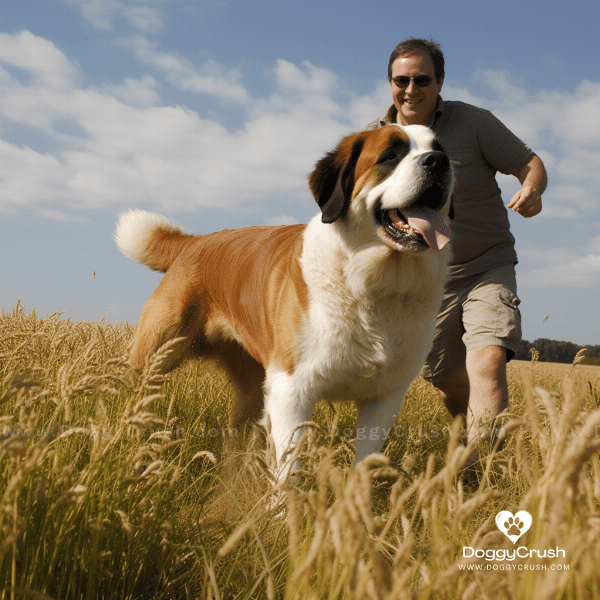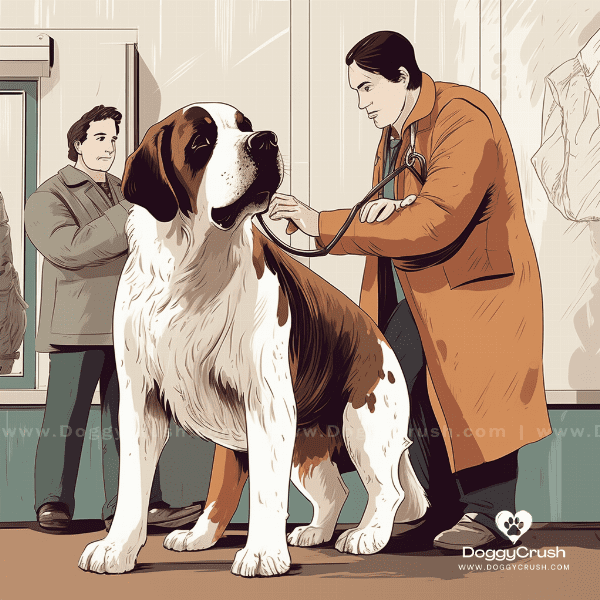Table of Contents
- A Brief History of Saint Bernard Dogs
- Physical Characteristics of Saint Bernard Dogs
- The Temperament of Saint Bernard Dogs
- Training and Socialization of Saint Bernard Dogs
- Feeding and Grooming Your Saint Bernard Dog
- Exercise and Activity Requirements for Saint Bernard Dogs
- Common Health Issues in Saint Bernard Dogs
- Choosing the Right Saint Bernard Puppy for Your Family
- Saint Bernard Rescue and Adoption
- Conclusion: Is a Saint Bernard Dog Right for You?
A Brief History of Saint Bernard Dogs
Saint Bernard Dogs, also known as Alpine Mastiffs, have a rich and interesting history. The breed was developed in the Swiss Alps during the 17th century as a working dog for the hospice of Saint Bernard. The hospice, which was located on the Great St. Bernard Pass between Switzerland and Italy, was a monastery that provided a resting place for travelers and pilgrims making the treacherous journey through the mountains.
The Original Role of Saint Bernard Dogs
The monks at the hospice recognized the need for a dog that could help them with their duties, which included providing assistance to travelers, carrying supplies, and patrolling the grounds. The dogs that were initially used for these tasks were a mix of several breeds, including the Greater Swiss Mountain Dog, the Great Dane, and the Tibetan Mastiff. Over time, these dogs were selectively bred to create the Saint Bernard we know today.
The Rescue Legacy of Saint Bernard Dogs
One of the most famous roles of Saint Bernard Dogs is their reputation as rescue dogs. During the winter months, the St. Bernard Pass was prone to avalanches and blizzards, which made travel even more perilous. Saint Bernards were trained to search for lost travelers and dig through snowdrifts to rescue them. They also provided warmth and companionship to those in need until help arrived.
The Recognition and Evolution of Saint Bernard Dogs
The Saint Bernard breed became well-known in Europe during the 19th century and was brought to the United States in the late 1800s. Over time, the breed’s appearance and temperament were refined to better suit their role as companion dogs. Today, Saint Bernards are still beloved for their gentle nature, loyalty, and courage.
In conclusion, the Saint Bernard Dog is a breed with a fascinating history. Their original role as working dogs in the Swiss Alps has evolved over time to include their reputation as rescue dogs and beloved family pets. Understanding the breed’s history can help us appreciate the unique qualities that make Saint Bernards such a special breed.

Physical Characteristics of Saint Bernard Dogs
The Saint Bernard Dog is a large and impressive breed with a distinctive appearance. Here are some of the key physical characteristics of Saint Bernard Dogs.
Size and Weight
Saint Bernard Dogs are a large breed, with males typically standing 27 to 30 inches tall at the shoulder and weighing between 140 and 180 pounds. Females are slightly smaller, standing 25 to 28 inches tall and weighing between 120 and 140 pounds.
Coat and Color
Saint Bernard Dogs have a thick, dense coat that is typically either short or long. The short coat is smooth and close to the body, while the long coat is wavy and feathery. The most common colors for Saint Bernards are white with red or brown markings, although they can also be brindle or all white.
Head and Face
One of the most distinctive features of the Saint Bernard is its large head and face. The breed has a broad skull and a deep, square muzzle. The eyes are set deep and are usually brown, and the ears are medium-sized and hang close to the head.
Body and Build
Saint Bernard Dogs are muscular and powerful, with a broad chest and a deep, well-developed body. The legs are straight and strong, and the feet are large and well-padded. The breed has a distinctive rolling gait that is a result of their large size and heavy build.
Health and Lifespan
Saint Bernard Dogs are generally healthy, but they can be prone to certain health issues such as hip and elbow dysplasia, bloat, and heart conditions. With proper care and attention, Saint Bernards can live for 8 to 10 years.
In conclusion, the physical characteristics of Saint Bernard Dogs make them a unique and impressive breed. Their large size, distinctive coat, and powerful build are just a few of the traits that make them stand out. Understanding their physical characteristics can help us better appreciate the beauty and majesty of these remarkable dogs.

The Temperament of Saint Bernard Dogs
Saint Bernard Dogs are known for their gentle and affectionate nature. Here are some of the key temperament traits of Saint Bernard Dogs.
Loyalty and Affection
Saint Bernards are famously loyal dogs, and they form strong bonds with their owners and families. They thrive on attention and affection, and they are known for their gentle and loving nature.
Calm and Patient
Despite their large size, Saint Bernard Dogs are typically calm and patient animals. They are not overly active or energetic, and they are content to lounge around the house with their owners. However, they still require regular exercise and mental stimulation to keep them healthy and happy.
Protective Instincts
Saint Bernards have a strong protective instinct, and they will defend their owners and families if they feel threatened. However, they are not typically aggressive dogs, and they are unlikely to attack unless provoked.
Gentle with Children
Saint Bernard Dogs are known for being gentle and patient with children. They are excellent family pets and make great companions for kids of all ages. However, as with any dog, it is important to supervise interactions between children and dogs to ensure everyone stays safe.
Easygoing and Sociable
Saint Bernard Dogs are typically easygoing and sociable animals. They get along well with other dogs and pets, and they are friendly and outgoing with strangers. However, they still require socialization and training to ensure they are well-behaved and confident in a variety of situations.
In conclusion, the temperament of Saint Bernard Dogs is one of their most endearing qualities. Their gentle, affectionate nature, combined with their protective instincts and easygoing demeanor, make them wonderful family pets. Understanding their temperament can help us provide the love and care these special dogs deserve.

Training and Socialization of Saint Bernard Dogs
Like all dogs, Saint Bernard Dogs require proper training and socialization to become well-behaved and obedient companions. Here are some important things to keep in mind when training and socializing your Saint Bernard.
Start Early
It is important to begin training and socializing your Saint Bernard puppy as early as possible. This will help them develop good habits and behaviors from a young age, and will make training easier as they grow older.
Use Positive Reinforcement
Positive reinforcement is the most effective training method for Saint Bernard Dogs. This involves rewarding your dog for good behavior with treats, praise, or playtime. Punishment and negative reinforcement should be avoided, as it can lead to fear and anxiety in your dog.
Consistency is Key
Consistency is crucial when training your Saint Bernard Dog. This means using the same commands and training methods every time, and avoiding confusion or mixed messages. Consistency will help your dog understand what is expected of them, and will make training more effective.
Socialize Your Dog
Socialization is important for all dogs, and Saint Bernard Dogs are no exception. This involves exposing your dog to a variety of people, animals, and environments to help them feel comfortable and confident in different situations. Socialization should begin in puppyhood and continue throughout your dog’s life.
Consider Professional Training
If you are having difficulty training your Saint Bernard Dog, consider hiring a professional trainer. A trainer can provide guidance and support, and can help you address specific behavior issues or concerns.
In conclusion, training and socialization are important aspects of owning a Saint Bernard Dog. With proper training and socialization, your dog can become a well-behaved and obedient companion that brings joy and love to your family.

Feeding and Grooming Your Saint Bernard Dog
Proper feeding and grooming are important for the health and well-being of your Saint Bernard Dog. Here are some tips on how to feed and groom your Saint Bernard.
Feeding Your Saint Bernard
Saint Bernard Dogs are large and active, so they require a balanced and nutritious diet to support their energy needs. A high-quality dog food that is formulated for large breeds is recommended. Be sure to follow the feeding guidelines on the dog food package, and avoid overfeeding your dog, as this can lead to obesity and other health issues.
Grooming Your Saint Bernard
Saint Bernard Dogs have a thick, dense coat that requires regular grooming. Brushing your dog’s coat once or twice a week will help to remove loose hair and prevent matting. Bathing your dog every 3-4 months is also recommended, as this will help to keep their coat clean and healthy. Be sure to trim your dog’s nails regularly and clean their ears to prevent infections.
Hygiene and Dental Care
Good hygiene and dental care are also important for your Saint Bernard’s overall health. Brushing your dog’s teeth regularly will help to prevent dental issues such as gum disease and tooth decay. You should also clean your dog’s ears and check their eyes for any signs of irritation or infection.
Water and Exercise
Saint Bernard Dogs require plenty of fresh, clean water and regular exercise to stay healthy. Be sure to provide your dog with access to water at all times, and give them plenty of opportunities to exercise and play. Regular exercise will help to keep your dog’s weight under control and prevent boredom and anxiety.
In conclusion, feeding and grooming your Saint Bernard Dog are important aspects of responsible dog ownership. By providing your dog with a balanced and nutritious diet, regular grooming, and good hygiene and dental care, you can help them live a healthy and happy life.

Exercise and Activity Requirements for Saint Bernard Dogs
While Saint Bernard Dogs are known for their calm and gentle nature, they still require regular exercise and activity to maintain good health and prevent boredom. Here are some tips on how to keep your Saint Bernard active and engaged.
Daily Exercise
Saint Bernard Dogs should be provided with daily exercise to keep them healthy and fit. This can include walks, runs, or hikes, depending on your dog’s age and activity level. As a large breed, Saint Bernards are prone to joint issues, so it’s important to avoid excessive jumping or high-impact activities.
Mental Stimulation
In addition to physical exercise, Saint Bernard Dogs require mental stimulation to prevent boredom and anxiety. This can include games, puzzles, and interactive toys that challenge your dog’s mind and keep them engaged.
Swimming
Many Saint Bernard Dogs enjoy swimming, which is a great low-impact exercise option. If you have access to a pool or a safe body of water, consider taking your dog for a swim. However, always supervise your dog around water to ensure their safety.
Indoor Activities
During inclement weather or times when outdoor exercise is not possible, there are still plenty of indoor activities that can keep your Saint Bernard engaged. This can include training sessions, games of fetch, or simply playing with toys.
Senior Dogs
As Saint Bernard Dogs age, their exercise needs may decrease. Senior dogs may require shorter walks or less intense activities, but it’s still important to provide them with daily exercise and mental stimulation to keep them healthy and happy.
In conclusion, regular exercise and activity are important for the health and well-being of Saint Bernard Dogs. By providing your dog with daily exercise, mental stimulation, and safe and engaging activities, you can help them lead a happy and fulfilling life.

Common Health Issues in Saint Bernard Dogs
Like all breeds, Saint Bernard Dogs can be prone to certain health issues. Here are some common health concerns that Saint Bernard owners should be aware of.
Hip and Elbow Dysplasia
Hip and elbow dysplasia are common conditions in large breeds like Saint Bernard Dogs. These conditions occur when the hip or elbow joint doesn’t develop properly, leading to discomfort and pain. Regular exercise and maintaining a healthy weight can help prevent these conditions.
Bloat
Bloat, or gastric torsion, is a serious and potentially life-threatening condition that occurs when the stomach fills with gas and twists. Saint Bernard Dogs are particularly susceptible to bloat due to their deep chests. Symptoms include restlessness, vomiting, and difficulty breathing. If you suspect your dog has bloat, seek veterinary care immediately.
Heart Conditions
Saint Bernard Dogs can be prone to certain heart conditions, including dilated cardiomyopathy and subvalvular aortic stenosis. Regular veterinary check-ups can help to diagnose and treat these conditions.
Skin and Ear Infections
Saint Bernard Dogs can be prone to skin and ear infections, especially if their coat is not properly groomed or if they spend a lot of time in water. Regular grooming and cleaning can help prevent these issues.
Eye Conditions
Saint Bernard Dogs are prone to certain eye conditions, including entropion and ectropion, which can cause irritation and discomfort. Regular veterinary care can help prevent and treat these conditions.
In conclusion, while Saint Bernard Dogs are generally healthy, they can be prone to certain health issues. Regular veterinary care, proper grooming and hygiene, and maintaining a healthy weight and exercise routine can help prevent these issues and keep your Saint Bernard happy and healthy.

Choosing the Right Saint Bernard Puppy for Your Family
Choosing a Saint Bernard puppy is an exciting but important decision. Here are some tips on how to choose the right Saint Bernard for your family.
Research Breeder and Lines
Before choosing a Saint Bernard puppy, it is important to research the breeder and the bloodlines of the litter. Look for a breeder who is reputable and responsible, and who prioritizes the health and welfare of their dogs. Ask about health testing and any genetic conditions that may be present in the bloodline.
Consider Personality and Temperament
Saint Bernard puppies can have different personalities and temperaments, so it’s important to choose a puppy that matches your family’s lifestyle and needs. Look for a puppy that is friendly, outgoing, and social, and that gets along well with people and other animals.
Health and Appearance
When choosing a Saint Bernard puppy, it’s important to consider their health and appearance. Look for a puppy that is active, alert, and in good physical condition. Check their eyes, ears, and coat for any signs of irritation or infection. A healthy puppy should have clear eyes, clean ears, and a shiny coat.
Meet the Parents
Meeting the parents of the litter can give you a good idea of what your Saint Bernard puppy may be like as an adult. Observe their temperament, personality, and behavior, and look for any signs of aggression or anxiety.
Consider Your Lifestyle
Saint Bernard Dogs are large and active, so it’s important to consider your lifestyle when choosing a puppy. If you have a small living space or limited outdoor space, a Saint Bernard may not be the best fit. It’s also important to consider the time and resources required for grooming, exercise, and veterinary care.
In conclusion, choosing the right Saint Bernard puppy requires research, consideration, and patience. By researching the breeder and bloodlines, considering personality and temperament, and taking into account your lifestyle and needs, you can choose a puppy that will be a happy and healthy addition to your family.

Saint Bernard Rescue and Adoption
If you’re interested in adding a Saint Bernard to your family, consider adoption or rescue. Here are some things to keep in mind when adopting or rescuing a Saint Bernard.
Benefits of Adoption
Adopting a Saint Bernard can have many benefits. You can provide a loving home to a dog in need, and you may be able to save a life. Adoption fees are often lower than purchasing a puppy, and many adult dogs are already trained and socialized.
Finding a Rescue or Shelter
There are many Saint Bernard rescues and shelters across the country. You can search online or check with local animal shelters to find a rescue or shelter near you. Be sure to research the rescue or shelter and ask about their policies and procedures.
Evaluating the Dog
When adopting or rescuing a Saint Bernard, it’s important to evaluate the dog’s personality, behavior, and health. Ask about the dog’s history and any known health issues. Spend time with the dog and observe their behavior, looking for signs of aggression or anxiety.
Providing Care and Training
Once you’ve adopted or rescued a Saint Bernard, it’s important to provide proper care and training. This includes regular veterinary check-ups, proper grooming and hygiene, and training and socialization. Consider enrolling your dog in obedience classes or working with a professional trainer.
Being a Responsible Owner
As a Saint Bernard owner, it’s important to be a responsible and committed owner. This means providing proper care and attention, including exercise and mental stimulation, and being aware of any health concerns or issues. It’s also important to keep your dog safe and secure, and to follow local laws and regulations.
In conclusion, adopting or rescuing a Saint Bernard can be a rewarding and fulfilling experience. By finding a reputable rescue or shelter, evaluating the dog’s personality and health, and providing proper care and training, you can give a loving home to a dog in need and enjoy the companionship of a wonderful breed.

Conclusion: Is a Saint Bernard Dog Right for You?
After reading about the history, physical characteristics, temperament, training and socialization, feeding and grooming, exercise and activity requirements, common health issues, and rescue and adoption of Saint Bernard Dogs, you may be wondering if this breed is right for you.
Pros of Saint Bernard Dogs
Saint Bernard Dogs are known for their calm and gentle nature, loyalty, and affectionate personalities. They are excellent family dogs and are great with children. They also make good watchdogs and are protective of their family.
Cons of Saint Bernard Dogs
Saint Bernard Dogs are large and require regular exercise, grooming, and veterinary care. They are prone to certain health issues, and can be expensive to care for. They also shed heavily, which can be a concern for people with allergies.
Is a Saint Bernard Right for You?
If you have a large living space, enjoy outdoor activities, and are committed to providing proper care and attention, a Saint Bernard Dog may be a great fit for your family. However, if you have limited space or resources, or are not able to provide the necessary care and attention, a Saint Bernard may not be the best choice for you.
In conclusion, Saint Bernard Dogs are a wonderful breed with many positive attributes. By considering their personality, temperament, exercise and grooming requirements, and health concerns, you can determine if a Saint Bernard Dog is the right fit for you and your family.




